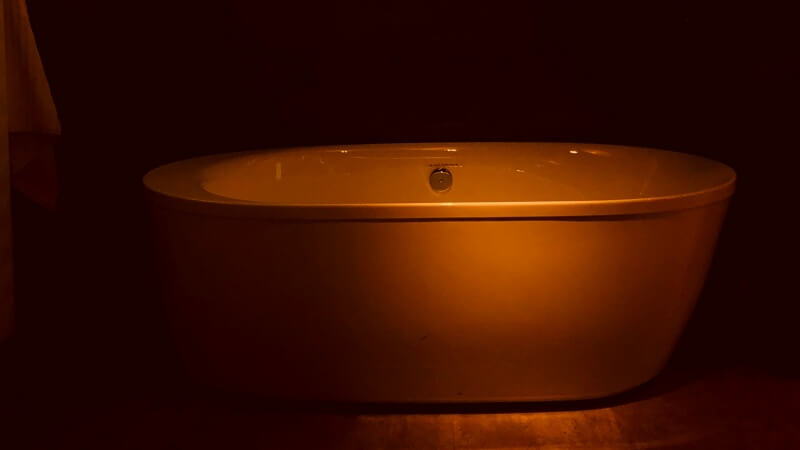
DIY Crafting A Cover For Your Portable Bathtub: A Creative Guide
Do you ever wish your portable bathtub had a bit more pizzazz or perhaps some added privacy? Well, you’re in luck! Crafting a DIY cover

Embracing the convenience of a portable bathtub brings with it the responsibility of upkeep, especially when it comes to preventing and eliminating odors.
These odors can stem from various sources and can diminish the overall joy and relaxation that a bath should provide.
This comprehensive guide aims to provide you with detailed and practical solutions to maintain your portable bathtub, ensuring it remains a pleasant and inviting space free from unpleasant smells.
A deeper understanding of what causes odors in your portable bathtub is essential to effectively tackle them. This section will explore the common reasons behind these unpleasant smells and offer insights into how you can prevent them.
The water quality used in your portable bathtub and the material it’s made from are significant contributors to the development of odors. Hard water can leave behind mineral deposits that not only create a breeding ground for bacteria but also emit a musty smell.
If your portable bathtub is made from materials like certain plastics or rubber, they can absorb odors over time, especially if they are not cleaned regularly. It’s crucial to understand the compatibility of cleaning agents with the material of your bathtub to prevent any damage during cleaning processes.
Improper cleaning and maintenance of your portable bathtub can lead to the accumulation of various substances that contribute to bad odors. This includes body oils, hair, dead skin, and product residues like soap and shampoo.
If these are not regularly cleaned, they can form a layer of scum on the bathtub’s surface, which not only looks unpleasant but can also harbor bacteria and mold, leading to a foul smell.
A thorough cleaning routine is essential to remove these substances effectively. Pay attention to hidden areas where water can accumulate and linger, as these spots are particularly prone to developing odors.
Stagnant water is a significant issue in portable bathtubs that can lead to the growth of bacteria and mold, both of which are notorious for causing bad odors. This often happens when water is not fully drained or if the bathtub is left damp. Ensuring complete drainage after each use is crucial.
Additionally, keeping the bathtub dry when not in use is equally important. Microbial growth not only causes unpleasant odors but can also pose health risks, making it essential to prevent it from occurring.
Consistent and thorough cleaning and maintenance of your portable bathtub are the primary defenses against the development of odors. Here, we will delve into effective cleaning practices and their importance in maintaining a fresh-smelling bathtub.
Regular cleaning of your portable bathtub is the cornerstone of preventing odors. This involves not just a superficial cleaning but a more in-depth approach that targets all areas of the bathtub, including those hard-to-reach spots.
Using the right cleaning agents that are effective against soap scum and body oils, yet gentle on the bathtub’s material, is essential. It’s also important to focus on areas where water may accumulate, as these can become hotspots for bacteria and mold growth.
Choosing the right cleaners and tools is key to effective cleaning. Harsh chemicals might do a good job of removing stains and scum but can damage the material of your bathtub, shorten its lifespan, or harm your skin during use. Opt for milder, eco-friendly cleaners that are effective yet gentle.
The tools you use, like brushes or sponges, should be soft enough not to scratch the surface of the bathtub. For tougher stains, consider using a cleaning agent that’s specifically designed to tackle hard water deposits or soap scum.
The material of your portable bathtub dictates the type of care it requires. For example, bathtubs made from softer materials like inflatable plastics require gentler cleaning methods to prevent punctures or tears.
On the other hand, harder materials like acrylic might withstand more vigorous scrubbing but are prone to scratching if abrasive tools are used. Always refer to the manufacturer’s instructions for specific care guidelines based on the material of your bathtub.
The quality of water used in your portable bathtub can significantly affect the development of odors. This section will explore how to manage and improve water quality to prevent odor issues.
The water used in your portable bathtub should be fresh and clean to prevent odors. If you live in an area with hard water, consider using a water softener to reduce mineral buildup. Frequent water changes are also crucial, especially if the bathtub is used regularly. Stagnant water can lead to the growth of bacteria and mold, contributing to unpleasant smells.
Incorporating a filtration system into your portable bathtub setup can greatly enhance water quality.
Filters can remove impurities and contaminants from the water, which helps in reducing odor development.
There are various portable water filters available that are easy to install and effective in purifying water. Regular maintenance of these filters is essential to ensure they remain effective.
Replacing the water in your bathtub regularly is vital for maintaining its freshness and preventing odors. Develop a routine for draining and refilling the bathtub, especially if it’s used frequently or left filled for extended periods. This practice not only keeps the water fresh but also reduces the likelihood of bacterial and mold growth.
Proactively taking steps to prevent long-term odor issues in your portable bathtub can ensure a consistently pleasant bathing experience. Let’s explore effective methods for odor prevention and control.
Natural odor eliminators can be a safe and effective way to neutralize bad smells in your portable bathtub. Baking soda, for example, is a natural deodorizer that can be sprinkled in the bathtub before cleaning. It helps in absorbing odors and breaking down residue. Vinegar, with its acidic properties, can also neutralize odors and is effective in removing hard water stains.
Preventing the growth of mold and mildew is crucial in controlling odors in your bathtub. These fungi thrive in damp environments, so ensuring your bathtub is completely dry after each use is vital. Store the bathtub in a dry, well-ventilated area to avoid dampness. Regular inspections for signs of mold and mildew are important, and immediate cleaning should be done if any growth is spotted.
In cases of persistent or strong odors, a deeper investigation into the causes may be required. This might involve checking for any leaks where water can collect and become stagnant.
Occasionally, parts of the bathtub, such as drainage plugs, may need to be replaced to resolve underlying issues that contribute to the odors.
If odors persist despite regular cleaning and maintenance, consider consulting a professional for a more thorough inspection and cleaning.
In conclusion, maintaining an odor-free portable bathtub requires a multifaceted approach involving regular cleaning, water quality management, and proactive measures to prevent microbial growth.
By understanding the causes of odors and implementing these effective strategies, you can ensure that your portable bathtub remains a fresh and inviting space for relaxation.
Regular maintenance not only enhances your bathing experience but also extends the lifespan of your bathtub.
Remember, taking the time to care for your portable bathtub will pay off in ensuring a hygienic and pleasant bathing environment.


Do you ever wish your portable bathtub had a bit more pizzazz or perhaps some added privacy? Well, you’re in luck! Crafting a DIY cover

Have you ever longed for extra comfort in your portable bathtub? Imagine enhancing your bathing experience with custom-made chairs and loungers tailored just for you.

When it comes to adding a personal touch to your home, your portable bathtub should not be an exception. This post will guide you through

Imagine stepping into your portable bathtub and finding the water temperature just perfect – every single time. This isn’t just a dream; it’s entirely achievable

Do you ever wish your portable bathtub had a bit more pizzazz or perhaps some added privacy? Well, you’re in luck! Crafting a DIY cover

Have you ever longed for extra comfort in your portable bathtub? Imagine enhancing your bathing experience with custom-made chairs and loungers tailored just for you.

When it comes to adding a personal touch to your home, your portable bathtub should not be an exception. This post will guide you through

Imagine stepping into your portable bathtub and finding the water temperature just perfect – every single time. This isn’t just a dream; it’s entirely achievable
Copyright © 2025 batheportablebathtub. All Rights Reserved.